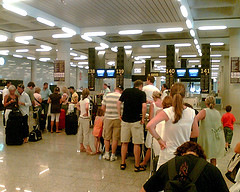 Ever wondered why time flies when you’re having fun, and from a business perspective what does it matter?
Ever wondered why time flies when you’re having fun, and from a business perspective what does it matter?
Trying to avoid the psychobabble (and if you’re into that aspect then see this article), here’s a potted rundown:
Time is subjective. Sure there is objective time but the point is that there is ample evidence that our experience of time or feeling of time passes will vary according to the context.
Think of it like our own internal clock ticking down the seconds or pulses. If we get distracted then pulses are sent less frequently so time seems to go faster. Our brain counts out metaphorically 60 pulses and says 1 minute but because the pulses are coming slower in fact 2 minutes have passed – hence the feeling that time went quickly.
Conversely if we’re stressed, scared or highly aroused then the pulses come faster. Our brain counts out those 60 metaphorical pulses and says that’s a minute but in fact its only say 30 seconds.
That is a really lay version of what really happens and a gross over-simplification but it probably serves the purpose for this post anyway.
Now that all might be very interesting but what does it mean for retail or business?
For many businesses, time is a factor in sales. Nowhere is this more the case than in captive retail environments such as airports. If people are in a headspace where they’re perceiving time quickly then they’re not going to spend much time in your shop considering the options, they get annoyed by queues, they rush off to departure lounges (or other things they need to do) because they don’t think they’ve got much time left.
 Even though you may objectively be serving them quickly, they sense it as being slow and get annoyed, frustrated and turned off.
Even though you may objectively be serving them quickly, they sense it as being slow and get annoyed, frustrated and turned off.
That queue which objectively is only 5 minutes seems like it took half an hour to get through. You get my drift.
As a quick aside the subjectivity of time measurement should raise some serious questions from a market research perspective too. How many companies get feedback about queues taking too long? How often do you try to ask people how long they spent somewhere? If time is subjective then you’re measuring their sense of how much time they spent not how much time they actually spent. If you want that you need to use objective tracking methods not interviews.
Back to the main issue here, if time perception is subjective then how can we influence it? How can we get people to feel like they’re not spending too much time in our shop but actually they are? How can we de-sensitise queue length in places where there are no choice but to have queues? Or in captive retail environments how can we get them to spend more time shopping and not panic that they need to get to the departure lounges?
It comes back to looking at what stimulates the sense that time moves quickly or slowly. Look at what does it and try to replicate that within our retail or business environments.
So, what do we know impacts on time perception?
-
Time goes faster in pleasant environments than in unpleasant environments. We all know that time flies when we’re talking to friends and crawls when you’re being yelled at by the boss. So the obviously take-out is to create an emotionally pleasant environment – not rocket-science I know but consider the flip-side of this. If you want time to crawl, if you want people to feel like they’ve already spent too much time somewhere and move quickly then make it less pleasant – create some emotional dissonance, something to make them feel a tad uncomfortable like dissonant colours, music which grates a bit etc.
-
Being distracted makes the pulses go slower so it feels like less time has passed. So if you have to have queues look for things to distract them. The worst thing possible is a queue where the only thing to look at is the other people in the queue and the only thing to think about is how long you’ve been in that queue.
Think about the other things which distract – music (but only something they like because if they don’t like it, its dismissed immediately and just gets annoying), variation in design, movement, variation in lighting, information on the products – all things which take some time to process and make time feel like its moving slower than it actually is.
Conversely of course, if you’re in a retail environment where people need to move very quickly then reverse this – keep things very low in distractions.
-
Facial expressions of anger & fear make people over-estimate time – in other words in makes people think they’ve spent 5 minutes arguing with you rather than 1 minute in reality – it dilates time.
 Curiously enough, expressions of disgust don’t seem to have this same impact. It is one of the fascinating quirks in this research which suggests that people underestimate time when they’re looking at something disgusting perhaps because they pay more attention to it and hence it slows down the processing of time.
Curiously enough, expressions of disgust don’t seem to have this same impact. It is one of the fascinating quirks in this research which suggests that people underestimate time when they’re looking at something disgusting perhaps because they pay more attention to it and hence it slows down the processing of time.Also perhaps interesting is that a bright smiling face tends to also dilate time but not to the same degree as anger. The reason for this is presumably that its a super clear message which takes little time to process.
Shame, though not a basic emotion, tends to create an under-estimate of time, which is hypothesised to happen because it requires more mental attention to process the expression.
What does that mean, probably that bright smiley faces in an unpleasant situation like a queue is almost as bad as being grumpy or looking scared. You’re actually better being a little more neutral – smile yes but not so overtly. Also, a look of shame for making people wait wouldn’t go astray.
However, if you’re a fast service business and want people to move quickly then wack on the bright smiley faces or even better look grumpy or scared witless – sorry, not serious there, but the bright smiley faces bit is right – just ask McDonalds.
-
People attempt to harmonise or synchronise our time perception with those we’re with or interacting with. When people are with (or see) elderly faces they tend to under-estimation of time. Interestingly enough this also correlates with another study back in 1996 by Bargh et al which showed that people walk more slowly around older people or even walk more slowly when primed to think about things related to older people.
A lot of this relates to social mimicry which is probably the topic of an entirely different article because it too has application in retail environments.
If people see youthful, vibrant people they tend to under-estimate time and it moves more quickly for them.
So again if you have an environment where you want to reduce the perception of time passing then look to older people, if you want to keep things moving quickly then look to surrounding customers with youthful faces.
The obvious application of a lot of this is in the use of staff but it goes beyond that. Think about your signage, the colours you use, the images on your walls, even the store display. We all know there are colours which appear older and those which appear youthful (and I’m saying older here not old & decrepit). Facial expressions on instore posters – ever noticed that in upmarket designer stores the models tend to have rather neutral expressions and you rarely if ever see them beaming like cheerful cherubs? The list goes on. Think about it, manipulating time is possible.
Images : ToniVC/Flickr, Brymo/Flickr



